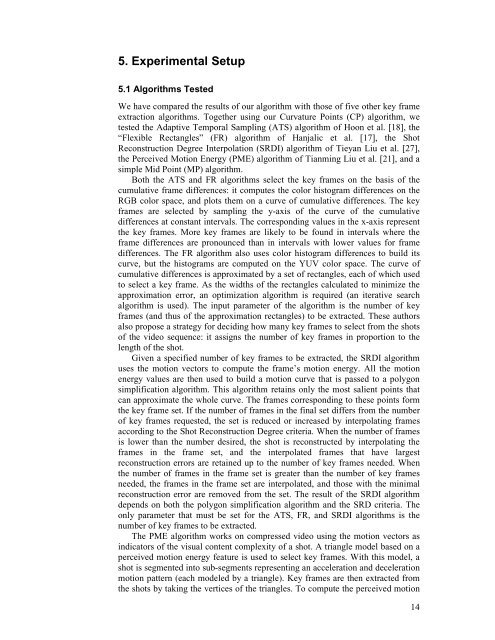an innovative algorithm for key frame extraction in video ...
an innovative algorithm for key frame extraction in video ...
an innovative algorithm for key frame extraction in video ...
You also want an ePaper? Increase the reach of your titles
YUMPU automatically turns print PDFs into web optimized ePapers that Google loves.
5. Experimental Setup5.1 Algorithms TestedWe have compared the results of our <strong>algorithm</strong> with those of five other <strong>key</strong> <strong>frame</strong><strong>extraction</strong> <strong>algorithm</strong>s. Together us<strong>in</strong>g our Curvature Po<strong>in</strong>ts (CP) <strong>algorithm</strong>, wetested the Adaptive Temporal Sampl<strong>in</strong>g (ATS) <strong>algorithm</strong> of Hoon et al. [18], the“Flexible Rect<strong>an</strong>gles” (FR) <strong>algorithm</strong> of H<strong>an</strong>jalic et al. [17], the ShotReconstruction Degree Interpolation (SRDI) <strong>algorithm</strong> of Tiey<strong>an</strong> Liu et al. [27],the Perceived Motion Energy (PME) <strong>algorithm</strong> of Ti<strong>an</strong>m<strong>in</strong>g Liu et al. [21], <strong>an</strong>d asimple Mid Po<strong>in</strong>t (MP) <strong>algorithm</strong>.Both the ATS <strong>an</strong>d FR <strong>algorithm</strong>s select the <strong>key</strong> <strong>frame</strong>s on the basis of thecumulative <strong>frame</strong> differences: it computes the color histogram differences on theRGB color space, <strong>an</strong>d plots them on a curve of cumulative differences. The <strong>key</strong><strong>frame</strong>s are selected by sampl<strong>in</strong>g the y-axis of the curve of the cumulativedifferences at const<strong>an</strong>t <strong>in</strong>tervals. The correspond<strong>in</strong>g values <strong>in</strong> the x-axis representthe <strong>key</strong> <strong>frame</strong>s. More <strong>key</strong> <strong>frame</strong>s are likely to be found <strong>in</strong> <strong>in</strong>tervals where the<strong>frame</strong> differences are pronounced th<strong>an</strong> <strong>in</strong> <strong>in</strong>tervals with lower values <strong>for</strong> <strong>frame</strong>differences. The FR <strong>algorithm</strong> also uses color histogram differences to build itscurve, but the histograms are computed on the YUV color space. The curve ofcumulative differences is approximated by a set of rect<strong>an</strong>gles, each of which usedto select a <strong>key</strong> <strong>frame</strong>. As the widths of the rect<strong>an</strong>gles calculated to m<strong>in</strong>imize theapproximation error, <strong>an</strong> optimization <strong>algorithm</strong> is required (<strong>an</strong> iterative search<strong>algorithm</strong> is used). The <strong>in</strong>put parameter of the <strong>algorithm</strong> is the number of <strong>key</strong><strong>frame</strong>s (<strong>an</strong>d thus of the approximation rect<strong>an</strong>gles) to be extracted. These authorsalso propose a strategy <strong>for</strong> decid<strong>in</strong>g how m<strong>an</strong>y <strong>key</strong> <strong>frame</strong>s to select from the shotsof the <strong>video</strong> sequence: it assigns the number of <strong>key</strong> <strong>frame</strong>s <strong>in</strong> proportion to thelength of the shot.Given a specified number of <strong>key</strong> <strong>frame</strong>s to be extracted, the SRDI <strong>algorithm</strong>uses the motion vectors to compute the <strong>frame</strong>’s motion energy. All the motionenergy values are then used to build a motion curve that is passed to a polygonsimplification <strong>algorithm</strong>. This <strong>algorithm</strong> reta<strong>in</strong>s only the most salient po<strong>in</strong>ts thatc<strong>an</strong> approximate the whole curve. The <strong>frame</strong>s correspond<strong>in</strong>g to these po<strong>in</strong>ts <strong>for</strong>mthe <strong>key</strong> <strong>frame</strong> set. If the number of <strong>frame</strong>s <strong>in</strong> the f<strong>in</strong>al set differs from the numberof <strong>key</strong> <strong>frame</strong>s requested, the set is reduced or <strong>in</strong>creased by <strong>in</strong>terpolat<strong>in</strong>g <strong>frame</strong>saccord<strong>in</strong>g to the Shot Reconstruction Degree criteria. When the number of <strong>frame</strong>sis lower th<strong>an</strong> the number desired, the shot is reconstructed by <strong>in</strong>terpolat<strong>in</strong>g the<strong>frame</strong>s <strong>in</strong> the <strong>frame</strong> set, <strong>an</strong>d the <strong>in</strong>terpolated <strong>frame</strong>s that have largestreconstruction errors are reta<strong>in</strong>ed up to the number of <strong>key</strong> <strong>frame</strong>s needed. Whenthe number of <strong>frame</strong>s <strong>in</strong> the <strong>frame</strong> set is greater th<strong>an</strong> the number of <strong>key</strong> <strong>frame</strong>sneeded, the <strong>frame</strong>s <strong>in</strong> the <strong>frame</strong> set are <strong>in</strong>terpolated, <strong>an</strong>d those with the m<strong>in</strong>imalreconstruction error are removed from the set. The result of the SRDI <strong>algorithm</strong>depends on both the polygon simplification <strong>algorithm</strong> <strong>an</strong>d the SRD criteria. Theonly parameter that must be set <strong>for</strong> the ATS, FR, <strong>an</strong>d SRDI <strong>algorithm</strong>s is thenumber of <strong>key</strong> <strong>frame</strong>s to be extracted.The PME <strong>algorithm</strong> works on compressed <strong>video</strong> us<strong>in</strong>g the motion vectors as<strong>in</strong>dicators of the visual content complexity of a shot. A tri<strong>an</strong>gle model based on aperceived motion energy feature is used to select <strong>key</strong> <strong>frame</strong>s. With this model, ashot is segmented <strong>in</strong>to sub-segments represent<strong>in</strong>g <strong>an</strong> acceleration <strong>an</strong>d decelerationmotion pattern (each modeled by a tri<strong>an</strong>gle). Key <strong>frame</strong>s are then extracted fromthe shots by tak<strong>in</strong>g the vertices of the tri<strong>an</strong>gles. To compute the perceived motion14
















